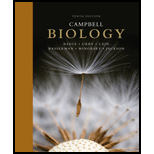
Campbell Biology Plus Masteringbiology
10th Edition
ISBN: 9780321775849
Author: Jane B. Reece, Lisa A. Urry, Michael L. Cain, Steven A. Wasserman, Peter V. Minorsky, Robert B. Jackson
Publisher: PEARSON
expand_more
expand_more
format_list_bulleted
Concept explainers
Textbook Question
Chapter 2, Problem 5TYU
Which of the following statements correctly describes any
- (A) The concentrations of products and reactants are equal.
- (B) The reaction is now irreversible.
- (C) Both forward and reverse reactions have halted.
- (D) The rates of the forward and reverse reactions are equal.
Expert Solution & Answer
Trending nowThis is a popular solution!

Students have asked these similar questions
Generate one question that requires a Punnet Squre to solve the question. Then show how you calculate the possibilities of genotype and phenotype
Briefly state the physical meaning of the electrocapillary equation (Lippman equation).
Explain in a small summary how:
What genetic information can be obtained from a Punnet square? What genetic information cannot be determined from a Punnet square?
Why might a Punnet Square be beneficial to understanding genetics/inheritance?
Chapter 2 Solutions
Campbell Biology Plus Masteringbiology
Ch. 2.1 - MAKE CONNECTIONS Explain how table salt has...Ch. 2.1 - Is a trace element an essential element? Explain.Ch. 2.1 - Prob. 3CCCh. 2.1 - MAKE CONNECTIONS Explain how natural selection...Ch. 2.2 - Prob. 1CCCh. 2.2 - A nitrogen atom has 7 protons, and the most common...Ch. 2.2 - Prob. 3CCCh. 2.2 - Prob. 4CCCh. 2.3 - Why does the structure H C = C H fail to make...Ch. 2.3 - What holds the atoms together in a crystal of...
Ch. 2.3 - What holds the atoms together in a crystal of...Ch. 2.4 - Prob. 1CCCh. 2.4 - Which type of chemical reaction, if any, occurs...Ch. 2.4 - WHAT IF? Write an equation that uses the products...Ch. 2 - Prob. 2.1CRCh. 2 - DRAW IT Draw the electron distribution diagrams...Ch. 2 - In terms of electron sharing between atoms,...Ch. 2 - What would happen to the concentration of products...Ch. 2 - Level 1: Knowledge/Comprehension 1. In the term...Ch. 2 - Compared with 31P, the radioactive isotope 32P has...Ch. 2 - The reactivity of an atom arises from (A) the...Ch. 2 - Which Statement is true of all atoms that are...Ch. 2 - Which of the following statements correctly...Ch. 2 - Prob. 6TYUCh. 2 - The atomic number of sulfur is 16. Sulfur combines...Ch. 2 - What coefficients must be placed in the following...Ch. 2 - DRAW IT Draw Lewis dot structures for each...Ch. 2 - EVOLUTION CONNECTION The percentages of naturally...Ch. 2 - Prob. 11TYUCh. 2 - Prob. 12TYUCh. 2 - Prob. 13TYU
Additional Science Textbook Solutions
Find more solutions based on key concepts
True or false? Some trails are considered vestigial because they existed long ago.
Biological Science (6th Edition)
1. Rub your hands together vigorously. What happens? Discuss the energy transfers and transformations that take...
College Physics: A Strategic Approach (3rd Edition)
Single penny tossed 20 times and counting heads and tails: Probability (prediction): _______/20 heads ________/...
Laboratory Manual For Human Anatomy & Physiology
How does the removal of hydrogen atoms from nutrient molecules result in a loss of energy from the nutrient mol...
SEELEY'S ANATOMY+PHYSIOLOGY
An obese 55-year-old woman consults her physician about minor chest pains during exercise. Explain the physicia...
Biology: Life on Earth with Physiology (11th Edition)
Knowledge Booster
Learn more about
Need a deep-dive on the concept behind this application? Look no further. Learn more about this topic, biology and related others by exploring similar questions and additional content below.Similar questions
- In a small summary write down:arrow_forwardNot part of a graded assignment, from a past midtermarrow_forwardNoggin mutation: The mouse, one of the phenotypic consequences of Noggin mutationis mispatterning of the spinal cord, in the posterior region of the mouse embryo, suchthat in the hindlimb region the more ventral fates are lost, and the dorsal Pax3 domain isexpanded. (this experiment is not in the lectures).a. Hypothesis for why: What would be your hypothesis for why the ventral fatesare lost and dorsal fates expanded? Include in your answer the words notochord,BMP, SHH and either (or both of) surface ectoderm or lateral plate mesodermarrow_forward
arrow_back_ios
SEE MORE QUESTIONS
arrow_forward_ios
Recommended textbooks for you
 Principles Of Radiographic Imaging: An Art And A ...Health & NutritionISBN:9781337711067Author:Richard R. Carlton, Arlene M. Adler, Vesna BalacPublisher:Cengage Learning
Principles Of Radiographic Imaging: An Art And A ...Health & NutritionISBN:9781337711067Author:Richard R. Carlton, Arlene M. Adler, Vesna BalacPublisher:Cengage Learning Biology (MindTap Course List)BiologyISBN:9781337392938Author:Eldra Solomon, Charles Martin, Diana W. Martin, Linda R. BergPublisher:Cengage Learning
Biology (MindTap Course List)BiologyISBN:9781337392938Author:Eldra Solomon, Charles Martin, Diana W. Martin, Linda R. BergPublisher:Cengage Learning Human Biology (MindTap Course List)BiologyISBN:9781305112100Author:Cecie Starr, Beverly McMillanPublisher:Cengage Learning
Human Biology (MindTap Course List)BiologyISBN:9781305112100Author:Cecie Starr, Beverly McMillanPublisher:Cengage Learning Biology: The Dynamic Science (MindTap Course List)BiologyISBN:9781305389892Author:Peter J. Russell, Paul E. Hertz, Beverly McMillanPublisher:Cengage Learning
Biology: The Dynamic Science (MindTap Course List)BiologyISBN:9781305389892Author:Peter J. Russell, Paul E. Hertz, Beverly McMillanPublisher:Cengage Learning

Principles Of Radiographic Imaging: An Art And A ...
Health & Nutrition
ISBN:9781337711067
Author:Richard R. Carlton, Arlene M. Adler, Vesna Balac
Publisher:Cengage Learning

Biology (MindTap Course List)
Biology
ISBN:9781337392938
Author:Eldra Solomon, Charles Martin, Diana W. Martin, Linda R. Berg
Publisher:Cengage Learning

Human Biology (MindTap Course List)
Biology
ISBN:9781305112100
Author:Cecie Starr, Beverly McMillan
Publisher:Cengage Learning



Biology: The Dynamic Science (MindTap Course List)
Biology
ISBN:9781305389892
Author:Peter J. Russell, Paul E. Hertz, Beverly McMillan
Publisher:Cengage Learning
Anaerobic Respiration; Author: Bozeman Science;https://www.youtube.com/watch?v=cDC29iBxb3w;License: Standard YouTube License, CC-BY